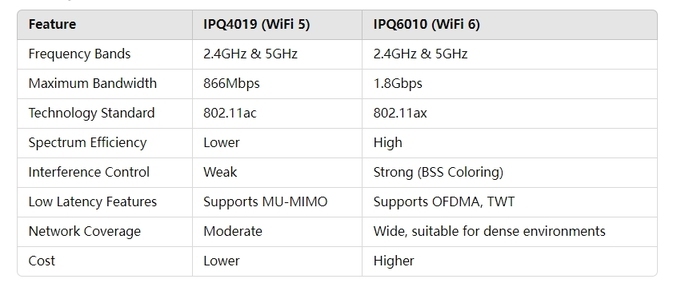Analysis of WiFi 5 IPQ4019 and WiFi 6 IPQ6010 Mesh Technology and Performance

Mesh Technology and Performance Analysis of WiFi 5 IPQ4019 and WiFi 6 IPQ6010
With the rapid advancement of wireless networking technology, Mesh networks have become an indispensable part of modern communication systems, especially in scenarios requiring wide-range and highly reliable wireless coverage. Two commonly used SoCs (System on Chip) for Mesh networking are the WiFi 5 IPQ4019 and WiFi 6 IPQ6010. Each of these chips offers unique advantages and limitations under different wireless standards. This article provides a comprehensive analysis of their performance, technical architecture, and application in Mesh networks.
1. WiFi 5 IPQ4019
1.1 Technical Features
The IPQ4019, launched by Qualcomm, is a WiFi 5 (802.11ac) based SoC primarily designed for mid-to-high-end routers and wireless access points. Its key technical features include:
Dual-Band Support: It supports both 2.4GHz and 5GHz bands, with a maximum bandwidth of up to 866Mbps (on the 5GHz band).
MU-MIMO: It supports Multi-User Multiple Input Multiple Output (MU-MIMO) technology, allowing simultaneous data transmission across multiple client devices, improving overall network efficiency.
Quad-Core Processor: Built on ARM Cortex-A7 quad-core architecture with a clock speed of 716MHz, it offers robust data processing capabilities, making it suitable for wireless networking needs in small to medium-sized homes and businesses.
1.2 Application in Mesh Networks
In the context of Mesh networks, the IPQ4019 offers the following benefits:
Stable Multi-Hop Networking: WiFi 5's mature technology and the IPQ4019 chip’s reliability make it ideal for medium-sized residential or office environments. Mesh nodes can form self-healing networks across dual frequency bands, ensuring communication continues even if certain nodes fail.
Cost-Effective Solution: Compared to WiFi 6 chips, the IPQ4019 offers a more economical deployment cost, making it a good fit for users or small businesses that do not require ultra-high-speed transmission.
1.3 Limitations
Although the IPQ4019 offers excellent value for money, it has some limitations when compared to newer WiFi 6 technology:
Bandwidth and Efficiency: While WiFi 5 supports MU-MIMO, its bandwidth and spectral efficiency are lower than WiFi 6, especially in high-density environments where network performance bottlenecks are more apparent.
Latency and Congestion Control: For latency-sensitive applications like online gaming or 4K video streaming, WiFi 5 underperforms compared to WiFi 6.
2. WiFi 6 IPQ6010
2.1 Technical Features
The IPQ6010 is part of Qualcomm’s WiFi 6 (802.11ax) chipset series, designed for high-density and high-traffic wireless environments. Its key strengths include:
OFDMA Technology: One of WiFi 6's core technologies, Orthogonal Frequency Division Multiple Access (OFDMA), significantly increases spectrum efficiency by allowing multiple users to transmit data simultaneously on the same channel, reducing congestion and transmission delays.
Target Wake Time (TWT): This technology optimizes device wake-up schedules, reducing unnecessary power consumption and extending battery life, particularly useful for smart home and IoT devices.
Higher Bandwidth and Speed: WiFi 6 provides much higher throughput than WiFi 5. The IPQ6010 supports a 160MHz channel bandwidth with a maximum data rate of up to 1.8Gbps.
BSS Coloring: By reducing interference from neighboring networks, this feature optimizes transmission efficiency in the same frequency band, especially in high-density scenarios.
2.2 Application in Mesh Networks
In Mesh network scenarios, the IPQ6010 delivers superior performance:
Wider Coverage and Faster Speed: WiFi 6's higher spectral efficiency and greater bandwidth allow Mesh networks to cover larger areas and enable faster data transfer between nodes. The IPQ6010 is particularly suited for large homes, commercial buildings, or high-density smart home environments.
Low Latency and Stable Connections: The combination of OFDMA and TWT technology reduces network latency and maintains stable connections by intelligently scheduling device communication, ensuring excellent network performance even when multiple devices are connected simultaneously.
2.3 Limitations
Despite its numerous advantages, the IPQ6010 faces certain challenges in some cases:
Higher Cost: WiFi 6 devices are more expensive compared to WiFi 5 counterparts. While they offer better performance, upgrading to WiFi 6 might not be the first choice for home users or small businesses on a budget.
Device Compatibility: Although WiFi 6 is backward compatible with WiFi 5 and older standards, to fully realize the benefits of WiFi 6, end devices must also support WiFi 6, which may hinder widespread adoption in the short term.
3. Comparison Between IPQ4019 and IPQ6010

4. Conclusion
Both the WiFi 5 IPQ4019 and WiFi 6 IPQ6010 offer unique advantages for Mesh networking and cater to different user scenarios. For small- to medium-sized homes or business networks with budget constraints, the IPQ4019 is a cost-effective solution. On the other hand, for those seeking higher performance, wider coverage, and lower latency—especially in high-density environments such as smart homes and commercial settings—the IPQ6010 excels and is worth considering for future upgrades. As WiFi 6 becomes more mainstream and costs decrease, it is likely to become the dominant choice in Mesh networking technology.










评论